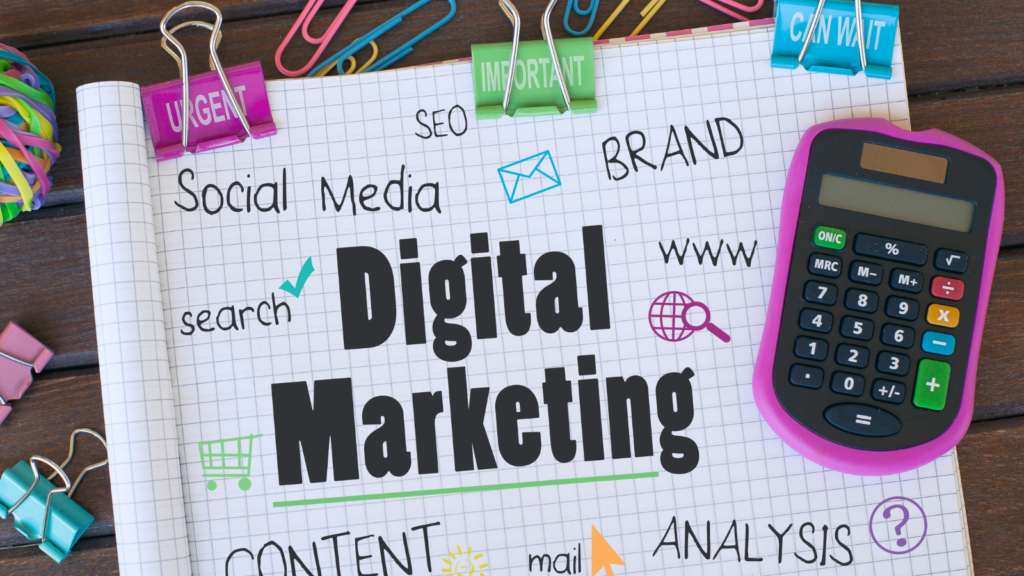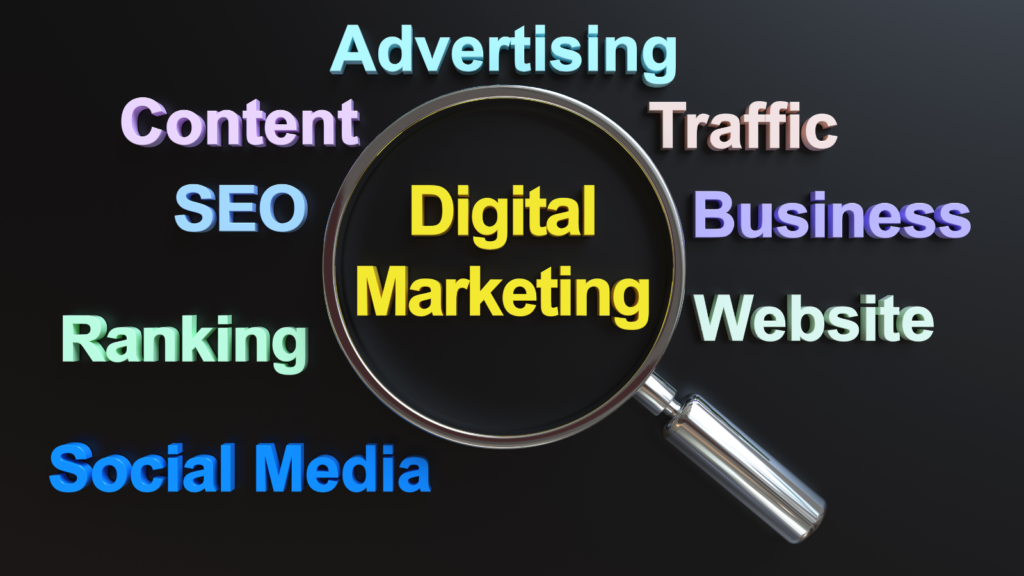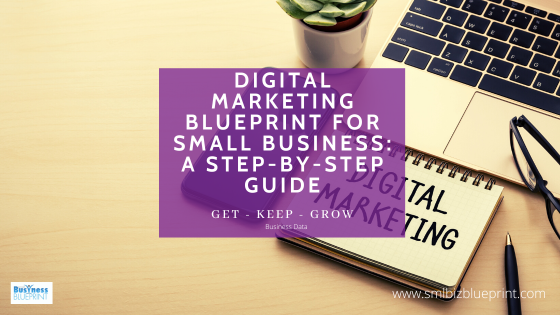In today’s fast-paced digital landscape, small and medium-sized enterprises (SMEs) must establish a strong online presence to compete and thrive.
A well-crafted digital marketing strategy can be a game-changer for Small Businesses, helping them connect with their target audience, drive brand awareness, and boost sales.

In this comprehensive guide, we’ll walk you through the step-by-step process of creating a robust digital marketing strategy tailored to your Small Business needs.
By the end of this article, you’ll clearly understand what to do, why it’s important, and how to implement each crucial step.
#1 Understanding Your Target Audience
Your journey to a successful digital marketing strategy starts with understanding your target audience inside and out.
- Who are your potential customers?
- What are their preferences, needs, and pain points?
Collecting and analysing demographic data, psychographic insights, and online behaviour patterns can create a buyer persona that guides your marketing efforts.
Example: Imagine you run a boutique fitness studio targeting health-conscious individuals. Knowing that your audience is predominantly young professionals seeking convenient workout options, you can tailor your messaging and channel selection accordingly.
Tip 1:
Conduct surveys and polls to gather insights directly from your audience about their preferences, pain points, and expectations.
Tip 2:
Utilize social media analytics to understand which posts resonate most with your audience and gather demographic data.
Tip 3:
Analyze competitor audiences to identify common traits and preferences among your potential customers.
#2 Defining Clear Goals and Objectives
Setting clear and achievable goals is essential to measure the effectiveness of your digital marketing strategy.
Whether it’s increasing website traffic, generating leads, or boosting online sales, ensure your goals are specific, measurable, attainable, relevant, and time-bound (SMART).
Example: A bakery aiming to boost online cake orders by 20% within the next quarter can track progress and make data-driven adjustments throughout the campaign.
Tip 1:
Identify your top business priorities and align your digital marketing goals accordingly, such as increasing sales, generating leads, or expanding brand awareness.
Tip 2:
Break down larger goals into smaller milestones to track progress more effectively and adjust as needed.
Tip 3:
Set a timeline for achieving your goals, specifying when you expect to see results to stay motivated and focused.

#3 Choosing the Right Digital Marketing Channels
Not all digital marketing channels are created equal, and your chosen ones should align with your goals and target audience.
Social media, email marketing, content marketing, search engine optimisation (SEO), and pay-per-click (PPC) advertising are just a few options.
Example: A local fashion boutique might prioritise Instagram and Facebook for visual content, while a B2B software provider may focus on LinkedIn and content marketing to showcase expertise.
Tip 1:
Research where your target audience spends online and prioritise those platforms for your initial marketing efforts.
Tip 2:
Experiment with various channels and analyse the results to identify which ones yield the best engagement and conversions.
Tip 3:
Leverage tools like Google Analytics and social media insights to track traffic sources, helping you understand which channels drive the most valuable traffic.
#4 Crafting Compelling Content
Content is the backbone of any digital marketing strategy.
Develop high-quality, valuable content that resonates with your audience’s needs and interests. This content can include blog posts, videos, infographics, and more.
Example: A landscaping company can create blog posts about seasonal lawn care tips and share video tutorials on planting techniques, establishing themselves as a trusted resource for homeowners.
Tip 1:
Identify your audience’s pain points and create content that addresses these issues, positioning your SME as a valuable solution provider.
Tip 2:
Develop a content calendar to ensure consistent posting across your chosen platforms, keeping your audience engaged and informed.
Tip 3:
Incorporate content formats such as blog posts, videos, infographics, and podcasts to cater to various audience preferences.
#5 Search Engine Optimization (SEO) Strategies
A well-optimized website ranks higher in search engine results, leading to increased organic traffic.
Conduct thorough keyword research, optimise on-page elements, and build authoritative backlinks to enhance your SME’s online visibility.
Example: An online pet store can target keywords like “best dog food brands” to attract pet owners looking for quality products.
Tip 1:
Use keyword research tools to find relevant keywords related to your industry and integrate them naturally into your website content.
Tip 2:
Optimize your website’s meta titles, descriptions, and headers to align with targeted keywords and improve search engine visibility.
Tip 3:
Focus on building high-quality backlinks from reputable websites in your industry to boost your site’s authority.

#6 Social Media Engagement and Advertising
Social media platforms provide a direct line of communication with your audience.
Engage organically by sharing valuable content and interacting with followers, and consider paid advertising to reach a wider audience effectively.
Example: A tech startup can run LinkedIn ads targeting professionals interested in innovative solutions, maximising their B2B reach.
Tip 1:
Create a content calendar for social media to maintain consistent posting and engage with your audience regularly.
Tip 2:
Use social media advertising platforms to target specific demographics, interests, and behaviours to reach your ideal customers.
Tip 3:
Encourage user-generated content by running contests or campaigns that involve your audience in creating and sharing content about your brand.
#7 Email Marketing Campaigns
Email marketing remains a powerful tool for building customer relationships.
Craft personalised, engaging emails that provide value through exclusive offers, informative newsletters, or educational content.
Example: A subscription box service can send personalised product recommendations based on customers’ past purchases, increasing cross-selling opportunities.
Tip 1:
Segment your email list based on customer interests, behaviours, and purchase history to deliver more personalised and relevant content.
Tip 2:
Craft attention-grabbing subject lines that entice recipients to open your emails, increasing your open rates.
Tip 3:
A/B test different email elements, such as subject lines, visuals, and call-to-action buttons, to identify the most effective strategies for your audience.
#8 Data Analytics and Measurement
Regularly monitor and analyse key performance indicators (KPIs) to gauge the success of your digital marketing efforts.
Adjust your strategy based on data insights to ensure continuous improvement.
Example: An e-commerce store can track conversion rates and analyse traffic sources to identify which marketing channels drive the most sales.
Tip 1:
Set up Google Analytics or other tracking tools to monitor website traffic, conversions, and user behaviour to gather valuable insights.
Tip 2:
Regularly review your analytics to identify trends and patterns, allowing you to make data-driven decisions and optimisations.
Tip 3:
Use heatmaps to visualise where users click and scroll on your website, helping you understand user behaviour and optimise page layouts.

#9 Budgeting and Resource Allocation
Effective resource allocation is vital for SMEs with limited budgets.
Determine how much you can invest in each channel and prioritise based on potential ROI and alignment with your goals.
Example: A local restaurant may allocate more budget to social media advertising during peak hours to drive dine-in traffic.
Tip 1:
Start with a small budget and allocate it based on the potential ROI of different channels. As you see positive results, consider scaling your investment.
Tip 2:
Prioritize channels that align with your audience and goals rather than spreading your budget too thin across all platforms.
Tip 3:
Monitor your spending and track your return on investment (ROI) for each channel to ensure your budget is used effectively.
#10 Adapting and Optimizing the Strategy
Digital marketing is an evolving landscape.
Regularly review and adapt your strategy to stay ahead of industry trends and respond to changes in your target audience’s preferences.
Example: As seasons change, a fashion e-commerce store can quickly shift its advertising focus from winter wear to summer outfits.
Tip 1:
Regularly review your digital marketing strategy and metrics to identify areas for improvement and optimisation.
Tip 2:
Stay informed about industry trends and emerging technologies that could impact your strategy, and be ready to adapt accordingly.
Tip 3:
Use A/B testing to compare different strategies and approaches to see which ones are more effective, allowing you to refine your approach over time.
Conclusion
Crafting a robust digital marketing strategy for your SME is a journey that demands careful planning, dedication, and adaptability.
You can create a strategy that drives meaningful results by understanding your audience, setting clear goals, choosing the right channels, and consistently measuring your performance.
Remember, the digital landscape is dynamic, so staying informed and willing to adjust your approach will be key to long-term success.
Ready to take your SME’s digital presence to the next level? Sign up for our newsletter to receive actionable insights and stay updated on the latest digital marketing trends.

FAQs
Q: What is the first step in creating a digital marketing strategy for my SME?
A: Understanding your target audience is the crucial first step. Gather data on demographics, preferences, and online behaviour to create a buyer persona that guides your strategy.
Q: How can I ensure my digital marketing goals are achievable?
A: Set SMART goals—specific, measurable, achievable, relevant, and time-bound. For instance, aim to increase online sales by 15% in the next six months.
Q: Which digital marketing channels should I prioritise for my SME?
A: Choose channels that align with your goals and target audience. Social media, content marketing, SEO, and email marketing are versatile options.
Q: How can data analytics benefit my digital marketing strategy?
A: Data insights allow you to measure performance, identify successful strategies, and make informed adjustments to optimise your efforts.
Q: Is it necessary to allocate a large budget to digital marketing?
A: No, effective budget allocation prioritises channels with the highest potential ROI. Even with a limited budget, strategic planning can yield significant results.
Q: What are the core elements of a robust digital marketing strategy?
A: A robust digital marketing strategy includes understanding your audience, setting clear goals, choosing appropriate channels, creating engaging content, optimising search engines, leveraging social media, utilising email marketing, analysing data, allocating resources wisely, and adapting over time.
Q: How often should I review and adjust my digital marketing strategy?
A: Regular review and adjustment are essential. Plan for quarterly or biannual reviews to assess performance, adapt to market changes, and fine-tune your strategy for optimal results.
Q: Can I create a digital marketing strategy with a limited budget?
A: Absolutely. Start by prioritising cost-effective channels that align with your goals. As your SME grows, you can allocate more resources to your strategy while focusing on ROI.
Q: What role does content play in a digital marketing strategy?
A: Content is the foundation of your strategy. It engages your audience, builds trust, and provides value. High-quality content boosts your SEO efforts, attracts traffic, and encourages conversions.
Q: How can I stay updated with the latest digital marketing trends?
A: Follow reputable industry blogs, attend webinars, join relevant online communities, and participate in workshops. Networking and continuous learning are key to staying ahead in digital marketing.
Implementing these actionable tips will empower Small Businesses to create and execute a robust digital marketing strategy that resonates with their audience, drives meaningful results, and paves the way for growth in the competitive digital landscape.




